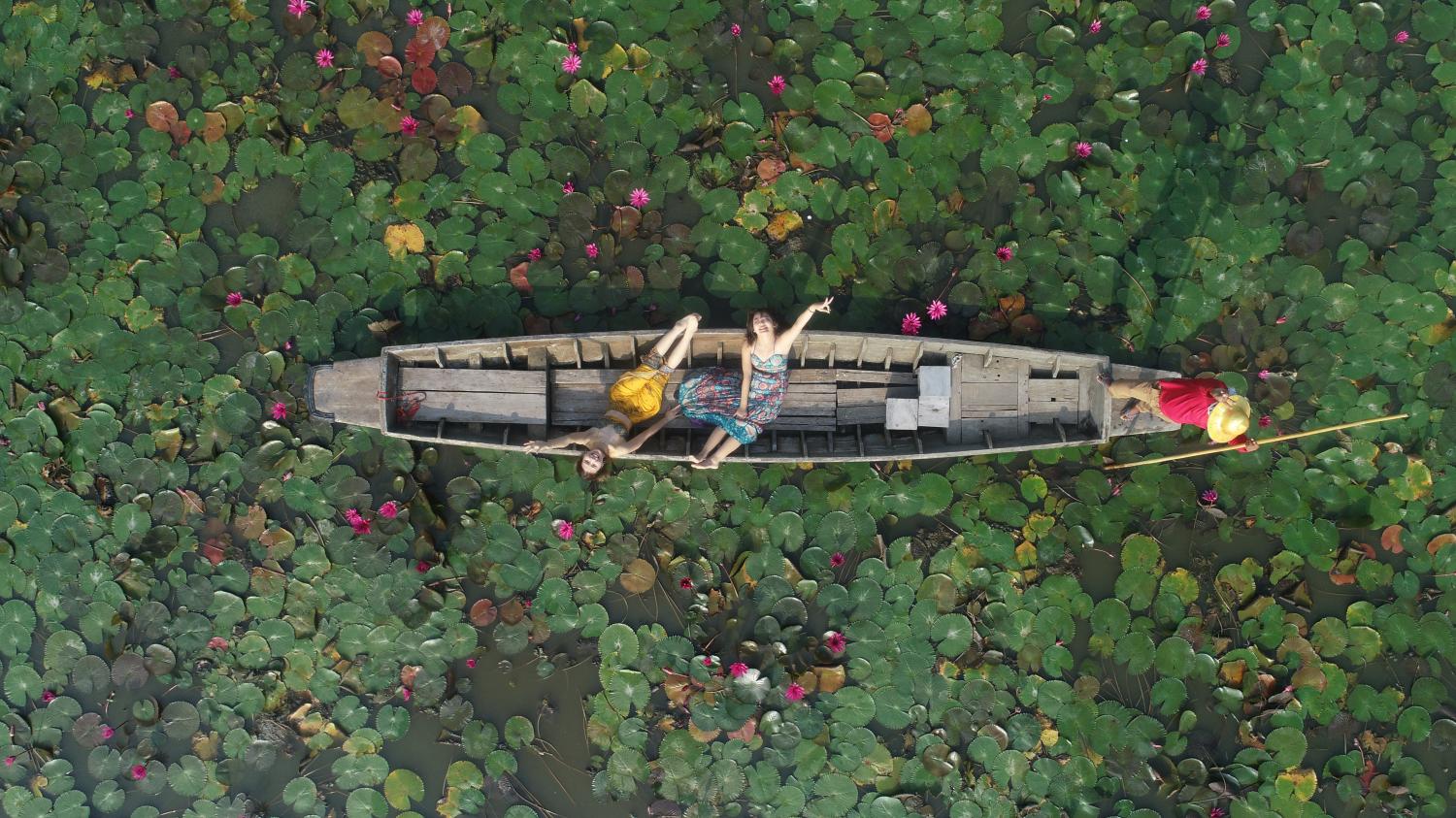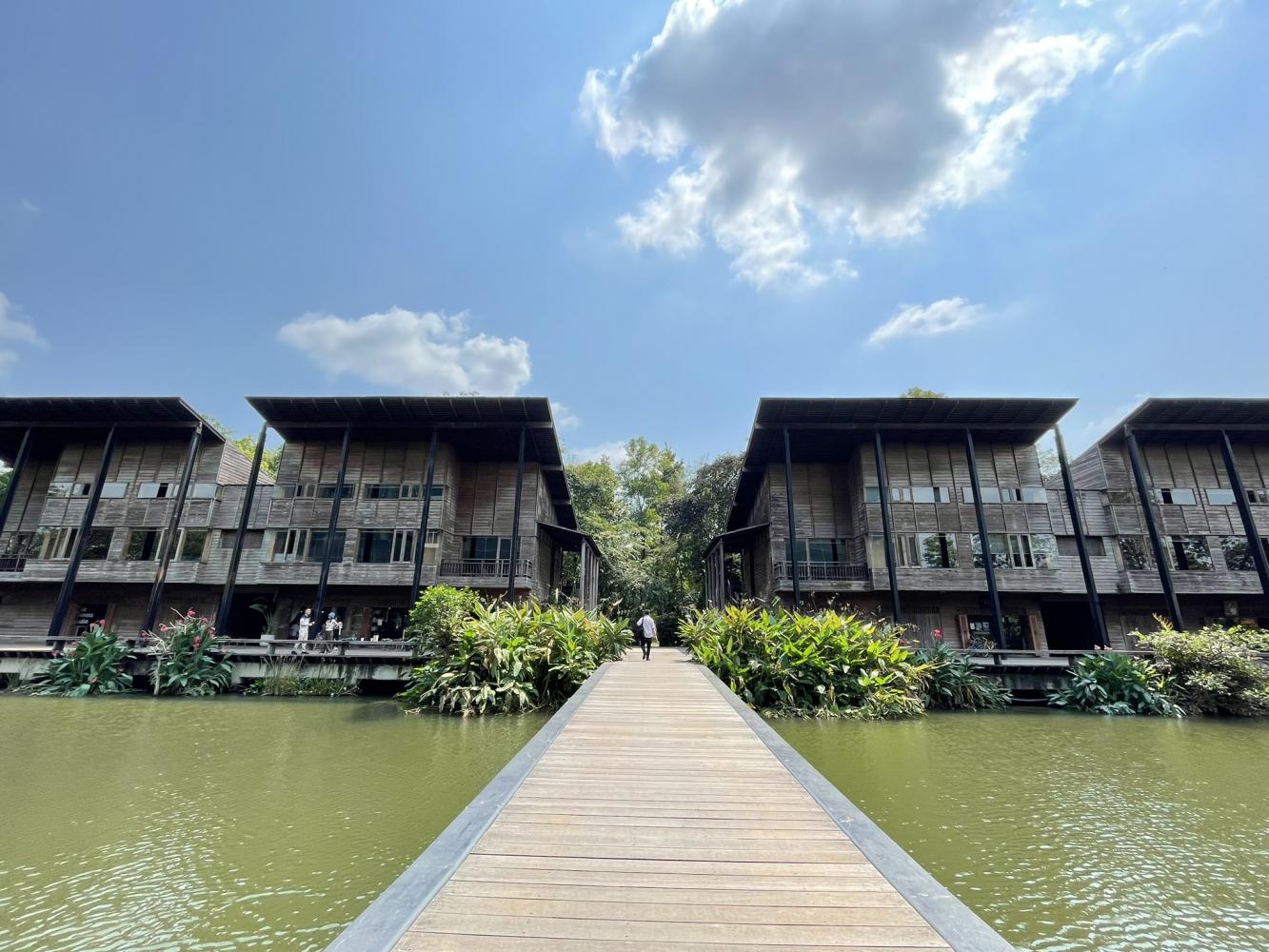As the temperature approaches 40C, Kasetsart University Kamphaeng Saen Campus in Nakhon Pathom evokes the springtime vibe of Ueno Park in Japan as a sea of pink trumpet trees begin to blossom.
According to the university, the best time to see the bloom is from Sunday until March 16. On Wattana Satien Sawat Road, the university spent more than 30 years growing over 200 pink trumpet trees to create a floral path, with the full bloom occurring between late February and mid-March.
It has become a popular destination for residents and tourists to celebrate the arrival of summer in Thailand. While horses grazed over the meadow, I chose to wander by a small canal and observe tourists posing like models and immersing themselves in the 3.5km tunnel of pink flowers.
After an hour admiring the natural beauty, visitors can pretend to be treasure hunters and explore the historic town of Nakhon Pathom, which was once a major trading hub along the banks of the Tha Chin River. Situated in the heart of the city, Wat Phra Ngam transports visitors back to the 12th and 16th Buddhist centuries when Dvaravati culture expanded its territory into Kamphaeng Saen and Nakhon Pathom.
This temple was declared a national historical monument in 1935 and boasts a sizable, ruined stupa on a hill, which is believed to have been built during the 11th and 12th centuries. A rare collection of white stone Buddha statues, lifelike demon-shaped sculptures, and clay votive tablets from the Dvaravati period were discovered during the excavation five years ago and relocated to the National Museum Bangkok.
During the Ayutthaya period, an old viharn with a Chinese junk-like base was erected to transport pilgrims through the cycle of life, according to Buddhist beliefs. Then, it was abandoned before being restored in the reign of King Rama V and a clay Buddha head was found by Prince Damrong Rajanubhab as he was touring the country to bring improvements to rural areas.

Floating among red lotuses.

At the Red Lotus Floating Market, a sea of red lotuses blossom all day.
Located 5km away, the remnants of the Dvaravati civilisation can be seen at Wat Phra Pathon Chedi Worawihan where a massive Dvaravati-style stupa was constructed out of red bricks and laterite. It was reconstructed on the same location after collapsing during the Ayutthaya period, and its base was embellished with stuccos that portrayed the life of the Lord Buddha.
Restored during the reign of King Rama IV, this stupa was classified as a national historical monument by the Fine Arts Department in 1940 and underwent renovations in 1968 and 2007. In order to invoke wealth and good fortune, pilgrims may sit in the ubosot and offer prayers to the highly revered Chiang Saen-style statue of Luang Pho To, the sandstone statue of Luang Pho Dam-Daeng, and relics of Buddha.
According to legend, the Thon Phrom Brahmin family, who immigrated to this town from India, built a stone house to contain an old gold scale that was formerly used to gather Buddha's relics. In 590, Thao Sri Sitthichai Phromthep asked the Brahman family for some gold measure so that he could exchange Buddha relics with the ruler of Lanka (modern-day Sri Lanka), but they were denied.
For this reason, Thao Sri Sitthichai Phromthep dispatched an army to take their gold and might have built Phra Pathom Chedi to house Buddha's relics from Lanka. Later, Phra Chao Kaka Wannadisarat of the Lavo kingdom built Phra Pathon Chedi in 656 to contain an archaic gold measure.

A ruined stupa from the Dvaravati era located in Wat Phra Ngam.

Another legend has it that Phraya Phan Thong was exiled from the palace because an astrologer had prophesied that he would murder his father, Phraya Kong, the monarch of the Nakhon Chai Si kingdom. Raised by poultry farmer Yai Hom, he learned from a wise ascetic until a ruler from Ratchaburi adopted him and appointed him a viceroy.
During that time, the Nakhon Chai Si kingdom ruled over Ratchaburi, so Phraya Phan Thong assisted his adoptive father in rebelling and killing Phraya Kong in a battle. When he realised Yai Hom raised him, he became furious and murdered her. As a penance, he built Phra Pathom Chedi and Phra Pathon Chedi as a tribute for Phraya Kong and Yai Hom.
This is the reason why worshippers today bring a large number of duck-shaped figurines to the Yai Hom Shrine, which is situated next to a pavilion of the Buddha's footprint. When it comes to finding a place for dinner after a long day, Phra Pathom Chedi's ground and the old market are both excellent options as they provide a wide selection of affordable street cuisine, local sweets and beverages.
The next morning, I headed to Bang Len district where a fish farm has been transformed into the Red Lotus Floating Market to reflect rural life. Opened in 2017, this old market resumed business nine months ago after a three-year hiatus and it is currently attracting domestic tourists and visitors from China, Hong Kong, Taiwan and South Korea.
Located along an irrigation canal, it is away from the highway and stretches 45 rai among a labyrinth of verdant plantations and rice paddies. At its heart, there's a massive 24 rai pond where visitors can take a pleasant 30-minute boat ride to fully immerse themselves in the vibrant sea of native red lotus and pink-purple lotus in full bloom.

Wat Phra Pathon Chedi Worawihan was built in the Dvaravati period.


"About 10 years ago, our owners noticed that Nakhon Pathom's tourist industry was expanding, so we transformed a fish farm into a tourist attraction where visitors could come and experience the way of life and wisdom of the waterside community. We grew two different kinds of lotus throughout the course of two years: the pink-purple Dang Mamuea lotus and the native red lotus found at Nong Han Lake in Udon Thani," said manager Suppachai Sunthonwiphat of the Red Lotus Floating Market.
"Using conventional agricultural practices, we eliminated chemicals from our land, and have improved the quality of water and soil to extend the life of our lotuses. We employ smart switch on/off technology to prevent chemical spills from surrounding fish and shrimp farms into our lotus pond."
A fleet of over 10 paddle boats, each accommodating five passengers, is moored at a dock and offers a 100 baht voyage against the backdrop of the azure sky. To capture priceless vacation moments with natural marvels, visitors can pay an extra 200 baht for vintage Thai costume services and 300 baht for drone photography services.
Visitors can view lotuses in bloom at any time of the day or night, as the natural red lotus usually shines from 9pm to 10.30am and the Dang Mamuea blooms from 8am to 7pm. Meanwhile, local vendors offer a variety of street food for a light meal and Bua Cafe serves miang kleeb bua (fresh lotus petals comes with dried shrimp, peanuts, sliced lemons, chilli, shallots, ginger and salt-chilli dip).

Sireeruckhachati Nature Learning Park is covered with an extensive array of herbal plants.


My next stop was the hidden Sireeruckhachati Nature Learning Park in Mahidol University Salaya Campus. In addition to providing a refuge for students to unwind and breathe fresh air, it allows guests to take a stroll and discover Thailand's herbal plants.
Covering 140 rai under the canopy of tall native trees, it is divided into seven zones where visitors can rent a bike or scooter for an hour-long self-guided tour. I decided to explore on foot, starting with the herbal garden and moved on to a zingiberaceous plant collection and a herbal area.
Visitors can learn about the various properties by scanning a QR code with their smartphone. For instance, the husks and seeds of Indian putat may heal mouth ulcers, the root of a star gooseberry can treat skin conditions and lower fever, the fruit and seeds of the java plum can relieve diarrhoea and dysentery, and wild teas can nourish impaired kidneys.
A wooden walkway along the lake is a good viewpoint to take in the striking scenery of green landscapes, while the nearby bird watching towers provide visitors with the opportunity to observe the lifestyles of the Asian brown flycatcher, taiga flycatcher, scarlet-backed flowerpecker, yellow-vented bulbuls and large hawk cuckoo.
After a quick walk from the herbal park to the Little Tree Grocery, I ended up cooling myself on a hot day with an iced matcha latte and a matcha soya chocolate cake. Opened in December, this is the latest addition to the College of Music's Artist Residency, which is designed to be a community space where people of all ages may gather and exchange experiences.
Standing between a large pond and a lush garden, the cafe uses organic herbal plants from the owner's home in Sam Phran district to create a wide range of healthy pastries, beverages and other condiments such as mulberry and roselle jam, lemon olive oil cakes, chilli cheese bagels and double chocolate cranberry sourdough.

Little Tree Grocery offers a wide range of pastries and coffee with organic herbs.


"This is the second branch of Little Tree Grocery in Sam Phran district. It is close to Bangkok, and provides convenience for our urban customers to stop by and grab some of their favourites like grandma's custard in coconut. We use organic herbs to spice up pastries and beverages, while a coffee roaster in Nakhon Pathom supplies us coffee blends," said Sirilak Riubamrung, an owner of Little Tree Garden and Whispering Cafes.
For those seeking keepsakes, this shop also provides a range of selected daily goods from different communities as well as home-cooked food alternatives, such as small shrimp paste and nipa palm sugar from Chumphon, and honey from Lamphun and Nakhon Si Thammarat.
Travel info
- Red Lotus Floating Market is located on Kan Prapa Nakhon Luang Road, Bang Len district, Nakhon Pathom. It's open Monday to Friday from 8am-5pm, and Saturday to Sunday from 7am-6pm. Call 081-259-7667 or visit facebook.com/RedLotusFloatingMarket.
- Sireeruckhachati Nature Learning Park is located in Mahidol University Salaya Campus on Phutthamonthon Sai 4 Road, Nakhon Pathom. It's open Wednesday to Sunday from 6am-6pm. Tickets are priced at 30 baht for students, 50 baht for adults and 150 baht for foreigners. Call 02-441-5272-4 or visit sireepark.mahidol.ac.th.
- Little Tree Grocery is in Artist Residency, College of Music, Mahidol University. It's open daily from 8am-6pm. Call 086-306-4852 or visit facebook.com/LittleTreeGrocery.

The iconic pink trumpet tree tunnel at Kamphaeng Saen Campus of Kasetsart University is expected to reach peak bloom this weekend.





